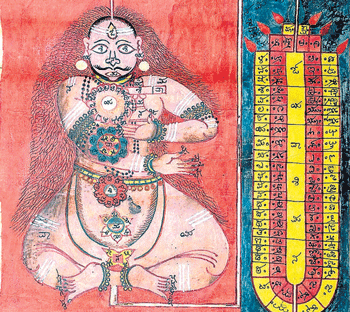For historians and research scholars, the ‘Hastaprati Bhandar’, a treasure trove of manuscripts, at the Institute of Kannada Studies of Gulbarga University is a paradise of sorts.
Housing over 6,000 manuscripts including the rarest ones, called ‘Uddharani’, each one of them tells its own story.
‘Uddharani’ is a form of pictorial manuscript explaining different philosophies. It is four to five meters long and can be conveniently rolled, like a scroll. It is very difficult to decipher the language in which the works are scripted. Colourful handdrawn pictures are pasted on a cloth.
According to experts, most of the ‘uddharanis’ are connected to ‘kaalajnana’ (futurology).
The laborious drawings in original colours are stunning. Traditional palm leaf manuscripts are the other important components of the collections. The earliest palm leaf manuscript is the work ‘Shivayoganga Bhushana’ and ‘Sadguru Rahasya’ by unknown authors (dated 22.2.1799). The works may be of an earlier period, but the manuscript is at least 210 years old.
Palm leaf manuscripts are said to have a longer shelf life, lasting even up to 600 years. The collection also contains some of the works of poet Nagavarma of the ninth-tenth century. Another important possession of the Institute is ‘Namalinganushasana’, popularly known as ‘Amarakosha’, written by Amara Simha of the 13th century. There are 180 palm leaf manuscripts running in to tens and hundreds of pages. The Institute also has over 4,000 paper manuscripts with the earliest one dating back to the 18th century.
All these manuscripts including the ‘uddharanis’ have been collected mostly from the Hyderabad-Karnataka region. They usually pertain to Veerashaiva philosophy, Sharana Sahitya and Vachana Sahitya. They are found in different literary forms including prose, poetry, drama, folk songs, folk tales, astrology, futurology, philosophy, bayalata (a form of performing theatre unique to North Karnataka), and medical literature. Though Kannada manuscripts outnumber the others, there are also scripts in Sanskrit and Telugu. The University has so far published two books from among the manuscripts.
They are ‘Kumar Vijaya Vilasa’, a work written in the 17th century, and ‘Yayathi’, a rare work on folk drama of bayalata form. The University is planning to bring out two more works based on these manuscripts as part of the ongoing Kannada Language Development Scheme of the State government.
It is only from the last one year that the priceless manuscripts, dumped in a room, have been opened and stored scientifically. K G Narayan Prasad, formerly with the Osmania University and now visiting professor of Gulbarga University, is busy giving a definite shape to the manuscripts. Cataloguing has also been going on. Prasad said the first volume will be ready in a couple of months.
All the manuscripts are being scanned and will be stored electronically, said Chairman of Institute of Kannada Studies D Nagabai Bulla.
The collection of manuscripts was undertaken in 1985-86 under a scheme sanctioned by the National Archives for five years. It was discontinued after three years as the University failed to submit proper accounts to the National Archives. “There is a dire need to collect the archives and establish an Archives of Manuscripts which can be made use of by scholars from all over India,’’ suggests Narayana Prasad.
source: http://www.DeccanHerald.com / Home> Supplements> Spectrum / by Srinivas Sirnoorkar / February 14th, 2012
